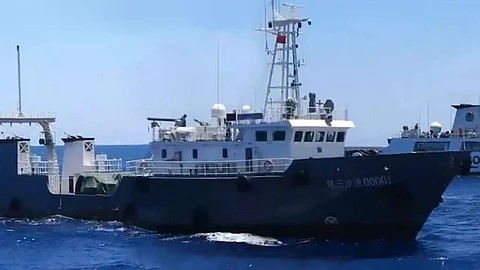

Maritime militias are usually government-controlled flotillas of civilian vessels that provide a cost-effective, deniable, and asymmetrical option for the support of national maritime interests. The craft deployed are almost always fishing vessels and often operate in large formations using “grey zone” tactics such as swarming and passive blockade.
Asian seaways, particularly within the South China Sea and its environs, are fraught with long-term disputes and confrontations. It is therefore not surprising that the region is increasingly a major hub for maritime militia activity.
China’s People’s Armed Forces Maritime Militia (PAFMM) is the largest and most highly organised of such forces, although its command and control is opaque and is a key node of Beijing’s hybrid warfare strategy. Analysts believe that the force has potential access to some 700,000 powered fishing vessels, ranging from small coastal craft to large, long-range “industrial-level” trawlers.
The larger PAFMM craft are classified as Spratly Backbone Fishing Vessels (SBFVs). Some SBFVs are fitted with reinforced hulls and ram bows. A few reportedly have a fixed armament of machine guns or light anti-aircraft guns but most rely upon an arsenal of small arms.
The PAFMM is also constructing a fleet of sturdy, high-powered “fishing vessels,” intended to take a lead role in its grey zone operations. Many of these new craft, at least some of which are being painted in China Coast Guard (CCG) livery, are being built on Hainan Island. The new paint scheme is leading some analysts to speculate that the force might in due course merge with the CCG.
Significant operations in which PAFFM vessels have played a major role include the battle for the control of the Paracel Islands (1974 ), the seizure of sonar equipment from the US Sealift Command’s underwater towed array surveillance ship Impeccable (2016), and swarming operations off Philippine-occupied Whitsun Reef (2020) and the Japan-claimed Senkaku Islands (2016).
Analysts believe that PAFMM vessels are manned by personnel inducted from military and fishing industry sources, with funding reportedly supplied by both government and fishing industry sources.
China’s prime regional maritime rival Vietnam has long been closely watching the growth of the PAFMM. In 2009, Hanoi instituted its own Maritime Militia, which is organised along provincial lines with its personnel receiving basic military training.
The reportedly 8,000-strong and expanding Vietnam Maritime Militia (VMM) has potential access to as many as 70,000 powered fishing vessels, while an approximately 200-strong class of dedicated craft is currently being built for the force at local shipyards. These new steel-hulled vessels, reportedly designated as the TK-1482 class, have ram bows and are fitted with Russian-made heavy machine guns.
Official duties of the VMM include prevention of illegal fishing, search and rescue, and maintenance of border security. The VMM operates extensively within Hanoi’s EEZ and played a major role in the 2014 stand-off involving the Haiyang Shiyou-981 drilling rig near the Paracels.
Over the past five years, China has stepped up its incursions into Indonesian-claimed waters and its harassment of Indonesian fishing vessels. Jakarta has until now relied mainly upon civilian patrol vessels of the Indonesian Maritime Security Agency and the Ministry of Maritime Affairs and Fisheries to monitor such activities.
Now, however, the Indonesian government has decided to form its own maritime militia using vessels from the nation’s fishing fleet. It remains to be seen when this plan will be fully activated and how effective it will be in responding to incursions.
The Philippines has many maritime disputes with China. It is therefore the country that receives the most attention from the PAFMM.
Manila’s response usually involves deploying the rapidly-expanding Philippine Coast Guard, but now, owing in part to strong political pressure being applied to the Philippine government, there are plans to induct fishing vessels and their crews into a maritime militia. A major catalyst for this move was the apparently spontaneous, deployment of a large flotilla of such craft to the vicinity of Scarborough Shoal in May of this year.
